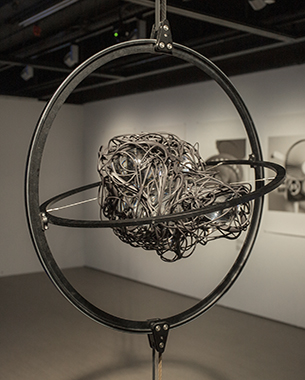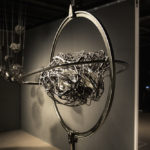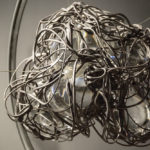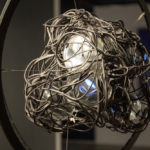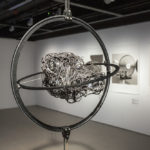Glass blown, 3D printed black polymer (SLS), Ferrofluid, 24 x Spherical Neodymium Magnets, Motor, Belt, Aluminum Gyroscope
Unruh (Blood Work 2.0) was made in 2020 through a collaboration between Tobias Klein, Victor Pok Yin Leung, and Jane Prophet. It is a biologically inspired, transparent kinetic sculpture filled with suspended Ferrofluid liquids contained in interlocking blown glass structures, engulfed in a net of augmenting 3D printed tendrils and supported by a gyroscope-like framework. The movement of the sculpture is based on the rotation in one axis and to the shift of the center of gravity, continuously influenced by a shift in magnetic fields, emitted by a series of moving magnets embedded in the 3D printed structures. Liquids move as the sculpture shifts and spins, creating higher complex entropic movements by reacting to changes in magnetic fields.
Machine Art, as discussed by Ezra Pound (1885-1972), contains the beauty of a machine process, best articulated in the movement, the motion of its parts. This has been articulated in various styles, depicting and translating movements, such as the Futurist painting or the cinematic aestheticisation of engines in films. It is however fully realized when art itself becomes a mechanical device – becomes a kinetic art.
The title of the artwork, Unruh, is referencing the history, the mechanical device nature, as it refers to the German word “Unrest” but is as well a technical term for the balance in each mechanical watch, providing the kinetic energy to propel the mechanics. The work has three main components, each relating to an idea of making and a medium of complexity and control. First, the work is propelled primarily by an engine that drives a belt, introducing a motion in one axis to the work. It is a linear movement, a source of energy induced into an otherwise stable system, in balance. Second, the main body of the work is balanced by two-axis, suspended within a gyroscope-like structure. Introducing the energy, through shifting the first axis, results in an imbalance that, through the second axis is continuously rebalanced resulting in a sudden shift of the work. Both are visible and reacting to re-stabilizing a system within the context of gravity, forming homeostasis within the shifting system. The third, is a system of spherical magnets, moving within a series of hollowed, tendril-like 3D printed black structures. The magnetic forces are invisible, however, the continuous shifting magnetic field augments the main gravitation-based system through the visible shift in the ferrofluids, contained within the glass central body. The delay of forces exchange between the rotation and the viscosity of the liquids creates a further imbalance of the system – leading to an entropic state of the work. The work is placed within the context of a kinetic balancing of energies within a growing entropic state, caused by shifting magnetic forces and centers of gravity.
Each of the systems become amalgamated within a simulation and exchange of force, set in the distinct media. The work is strongly set within the emerging discipline of Digital Craftmanship where the precise 3D printed elements, made using Computer-Aided Design (CAD) can be read as techne, which, for Heidegger, does not describe Technik (technology), but constitutes the “bringing-forth of the true into the beautiful”, (Heidegger 1977, 315), allowing the auto-poiesis of the liquids to react and form second-order cycles of feedback between systems – articulating energy exchange in cybernetic cycles, extending the basic definition of ‘how to’ into the genetics of the making, and the formal reaction of itself.
